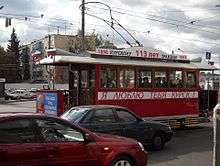Kursk
Kursk (Russian: Курск, IPA: [ˈkursk]) is a city and the administrative center of Kursk Oblast, Russia, located at the confluence of the Kur, Tuskar, and Seym rivers. The area around Kursk was the site of a turning point in the Soviet–German struggle during World War II and the site of the largest tank battle in history. Population: 415,159 (2010 Census);[5] 412,442 (2002 Census);[12] 424,239 (1989 Census).[13]
Kursk Курск | |
|---|---|
City[1] | |
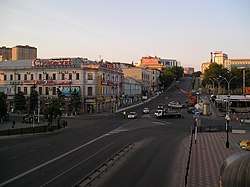 Kursk street view | |
 Flag  Coat of arms | |
Location of Kursk 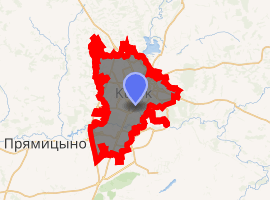
| |
 Kursk Location of Kursk 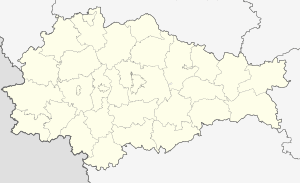 Kursk Kursk (Kursk Oblast) | |
| Coordinates: 51°43′N 36°11′E | |
| Country | Russia |
| Federal subject | Kursk Oblast[1] |
| First mentioned | 1032[2] |
| City status since | 1779[3] |
| Government | |
| • Body | Kursk City Assembly (Russian: Курское городское Собрание) |
| • Head | Alexander Zakurdayev |
| Area | |
| • Total | 188.75 km2 (72.88 sq mi) |
| Elevation | 250 m (820 ft) |
| Population | |
| • Total | 415,159 |
| • Estimate (2018)[6] | 448,733 (+8.1%) |
| • Rank | 42nd in 2010 |
| • Density | 2,200/km2 (5,700/sq mi) |
| • Subordinated to | city of oblast significance of Kursk[1] |
| • Capital of | Kursk Oblast[7][8], Kursky District[1] |
| • Urban okrug | Kursk Urban Okrug[9] |
| • Capital of | Kursk Urban Okrug[9], Kursky Municipal District[9] |
| Time zone | UTC+3 (MSK |
| Postal code(s)[11] | 305000 |
| Dialing code(s) | +7 4712 |
| OKTMO ID | 38701000001 |
| City Day | September 25 |
| Website | www |
History
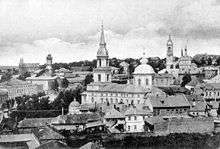
The first written record of Kursk is dated 1032.[2] It was mentioned as one of Severian towns by Prince Igor in The Tale of Igor's Campaign: "Saddle, brother, your swift steeds. As to mine, they are ready, saddled ahead, near Kursk; as to my Kurskers, they are famous knights—swaddled under war-horns, nursed under helmets, fed from the point of the lance; to them the trails are familiar, to them the ravines are known, the bows they have are strung tight, the quivers, unclosed, the sabers, sharpened; themselves, like gray wolves, they lope in the field, seeking for themselves honor, and for their prince, glory."[14]
The seat of a minor principality, Kursk was raided by the Polovtsians in the 12th and 13th centuries and destroyed by Batu Khan around 1237. The city was rebuilt no later than 1283. It was ruled by Grand Duchy of Lithuania between 1360 and 1508. Kursk joined the centralized Russian state in 1508, becoming its southern border province. It was an important center of the corn trade with Ukraine and hosted an important fair, which took place annually under the walls of the monastery of Our Lady of Kursk.
However, a century later the city re-emerged in a new place; date of re-considered grounds Kursk 1586 [9]. In 1596 a new fortress was built, in 1616 it was garrisoned by over 1,300 soldiers. At the beginning of the 17th century Kursk was repeatedly attacked by Polish-Lithuania (in 1612, 1616, 1617, 1634), the Crimean Tatars, and the Nogai horde, but Kursk fortress was never taken. Residents of Oryol and other southern Russian cities were resettled in Kursk (by 1678 2,800 had been resettled). The city developed due to its advantageous geographical position on the shortest route from Moscow to the Crimea and from Kiev to the Crimea.
It was raided frequently by the Polish–Lithuanian Commonwealth and Crimean Khanate until the late 17th century and was ruled by the Polish–Lithuanian Commonwealth between 1611 and 1618. It was successively part of the Kiev Governorate (1708–1727), Belgorod Governorate (1727–1779), and Kursk Viceroyalty (1779–1797). Town status was granted to Kursk in 1779.[3] It became the administrative center of Kursk Governorate in 1797.
After a fire in 1781 devastated Kursk, a new plan for the city was developed in which a market center would be at the heart of the city (it was erected in the central square, known as Red Square). In 1768 the Voskirsensko Ilinskaya Church was built (Russian: Воскресенско-Ильинская церковь). In 1778 both the Sergiev Cathedral Kazan Cathedral Baroque and Trinity Sergius Cathedral were completed. The city opened its first school for the nobility in 1783. A men's gymnasium was opened in 1808 and a seminary in 1817. A women's gymnasium was opened in 1870.
At the beginning of the 20th century Kursk played a dominant role in the food industry (Kvilitsu AK, one of the largest breweries in Russia, operated in Kursk) and in other industries as well; so, in the 1900s, appeared in the city 4 sitoproboynye shops (of which the largest was a workshop Tikhonov, products are sent to foreign markets - Germany, Austria-Hungary, etc.). Organized several engineering enterprises (in 1914 there were seven, including one - rail). Working conditions in the factories of Kursk were harsh and often resulted in strikes (for instance, from 1901-03 the workers at the sugar mill went on strike). Kursk workers participated in the general political strike during the 1905 Russian Revolution.
On November 26 (December 9,) 1917 the Soviets took power. Kornilovites came to Kursk in September 20, 1919. On September 20, 1919, troops under the command of General Denikin entered the city. On November 19, 1919, the Red Army took Kursk. The Soviet government valued Kursk for rich deposits of iron ore and developed it into one of the major railroad hubs in the Russian southwest. In 1932 in the Kursk was included Yamskaya Sloboda. In 1935 a tram system began operating in the city. In 193?, the territory of the city of Kursk was divided into Leninsky District (left bank of the Kura), Dzerzhinsky District (right bank of the Kura) and Kirov District (Yamskaya Sloboda). In 1937 Stalinsky District was formed in the southern outskirts of the city.
During World War II, Kursk was occupied by Germany between November 4, 1941 and February 8, 1943. In July 1943, the Germans launched Operation Citadel in an attempt to recapture Kursk. During the resulting Battle of Kursk, the village of Prokhorovka near Kursk became the center of a major armoured engagement – the Battle of Prokhorovka – between Soviet and German forces, which is widely considered to have been one of the largest tank battles in history. Operation Citadel was the last major German offensive against the Soviet Union.
Rebuilding efforts in the city began in February 1944. The cultural life recovered as well: on 19 February the cinema reopened and on February 27 the drama theatre. In 1953 the tram system began operating. By 1950 the urban economy had been completely restored. On August 17, 1956, Stalinsky District was renamed Promishlenost District, and Dzerzhinsky District was abolished and its territory divided between Promishlenost and Leninsky Districts.
In 2009, for the first time in 90 years at the site of Theotokos of Kursk, the most revered icon in the Russian Orthodox Church, received the name Hodigitria Russian diaspora.
Until 2010, Kursk had the status of historical settlement, but the Russian Ministry of Culture deprived the city of this status on July 29, 2010 in resolution № 418/339.
On October 28, 2011, for the first time in 30 years, the city opened a new firehouse for the protection of the Central District, with modern equipment. In 2012, Kursk celebrated its 980th anniversary.
Administrative and municipal status
Kursk is the administrative center of the oblast[7][8] and, within the framework of administrative divisions, it also serves as the administrative center of Kursky District, even though it is not a part of it.[1] As an administrative division, it is incorporated separately as the city of oblast significance of Kursk—an administrative unit with the status equal to that of the districts.[1] As a municipal division, the city of oblast significance of Kursk is incorporated as Kursk Urban Okrug.[9]
Economy and infrastructure
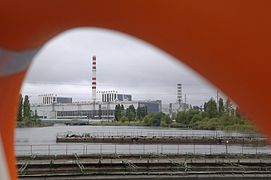
In addition to its importance as an administrative hub, Kursk is important as an industrial centre. Activity focuses on iron based industry, the chemical sector and a large food processing industry, reflecting the richness of agriculture in the surrounding "Black Earth" region.
Particularly noteworthy is the so-called Kursk Magnetic Anomaly (Russian: Курская магнитная аномалия), the world's largest known iron-ore reserve, where the iron content of the ore ranges from 35% up to 60%.
In Kurchatov, some 40 km (25 mi) to the south-west, is the Kursk Nuclear Power Plant, incorporating four RBMK-1000 ("High Power Channel-type Reactor") (Russian: Реактор Большой Мощности Канальный) reactors similar to those implicated in the 1986 Chernobyl disaster. The oldest of the Kursk reactors has been operational since 1977, and the newest of them since 1986.
Attractions
The oldest building in Kursk is the upper church of the Trinity Monastery, a good example of the transition style characteristic of Peter the Great's early reign. The oldest lay building is the so-called Romodanovsky Chamber, although it was erected in all probability in the mid-18th century, when the Romodanovsky family had ceased to exist.
The city cathedral was built between 1752 and 1778 in the splendid Baroque style and was decorated so sumptuously that many art historians attributed it to Bartolomeo Rastrelli. Although Rastrelli's authorship is out of the question, the cathedral is indeed the most impressive monument of Elizabethan Baroque not to be commissioned by the imperial family or built in the imperial capital.
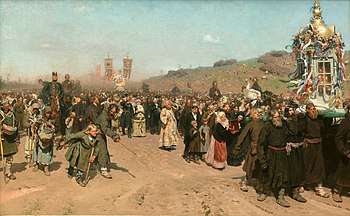
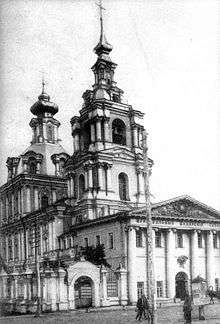
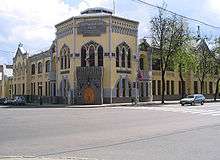
The cathedral has two stories, with the lower church consecrated to St. Sergius of Radonezh and the upper one — to the Theotokos of Kazan. The upper church is noted for an intricate icon screen which took sixteen years to complete. The three-story cathedral bell tower derives peculiar interest from the fact that Seraphim of Sarov, whose father took part in construction works, survived an accidental fall from its top floor at the age of seven. The Resurrection Church is also shown where St. Seraphim was baptized.
The monastery cathedral of the Sign (1816–26) is another imposing edifice, rigorously formulated in the purest Neoclassical style, with a cupola measuring 20 meters (66 ft) in diameter and rising 48 meters (157 ft) high. The interior was formerly as rich as colored marbles, gilding, and frescoes could make it. During the Soviet period, the cathedral was desecrated, four lateral domes and twin belltowers over the entrance pulled down. There are plans to restore the church to its former glory.
The modern city is a home for several universities: Kursk State Medical University, State Technical University, Kursk State University (former Pedagogical University) and Agricultural Academy, as well as the private Regional Open Social Institute (ROSI). There are also modern shrines and memorials commemorating the Battle of Kursk, both in the city and in Prokhorovka.
The Command Station Bunker & Museum was built specifically in memorial of the courageous Russian T-34 tank units that fought in the Battle of Kursk, where a T-34 tank is on display. Over 6,000 armored vehicles fought in close range over the open territory near Kursk in 1943.[15] This battle stopped the German advance into the Kursk Salient, and was a turning point of World War II on the Eastern Front.
Kursk played a role in the Cold War as host to Khalino air base.
Nearby is Tsentralno-Chernozemny Zapovednik, a large section of steppe soil that has never been plowed. It is used for a variety of research purposes.
Education
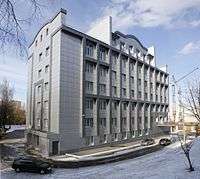 Regional Financial and Economic Institute
Regional Financial and Economic Institute Kursk State Agricultural Academy
Kursk State Agricultural Academy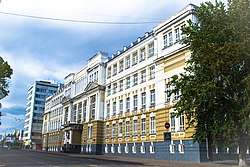
Transportation
Since 1868 there has been a railway connection between Kursk and Moscow.[16] Kursk is located on a major railway line between Moscow and Kharkov, with trains also linking the city to Voronezh and Kiev. The Kursk Vostochny Airport provides domestic flights. Public transport includes buses, trolleybuses, and trams. Since 2007, the public transport introduced a satellite navigation system. The total length of the road network of the city of Kursk is 595.8 km, of which 496.2 km of roads are paved. Roads of the city have access to federal highway M2 "Crimea", as well as on the highway A144 (Kursk - Voronezh - Saratov) and P199 (border with Ukraine).
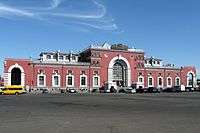
Kursk bound intercity bus routes to cities and towns Kursk region and neighboring regions (Belgorod Oblast, Bryansk Oblast, Voronezh Oblast, Oryol Oblast), as well as Moscow, St. Petersburg and cities of Ukraine: Kharkiv and Sumy. Long-distance buses arrive and depart from the bus station "Kursk", located in the North-West part of the city.
On September 5, 2011 in Kursk commissioned automated monitoring system fare.[17] Implementation of the system in operation is carried out by Kursk Integrated Ticket System was to take place in three stages: At the initial stage is implemented partially open version of the system, in which the sale of tickets and travel control social cards carried in the cabin of public transport conductors with handheld validators, the second stage involves the installation of stationary validators, third - commissioning turnstiles. After completion of the implementation, the automated monitoring system drive will operate in "closed" mode : turnstiles will be installed at the entrance and exit of passengers. As of September 2011 turnstiles installed on 44 buses, 10 trolley buses and trams 5.
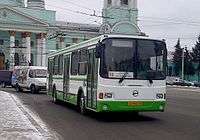 LiAZ-5256 bus
LiAZ-5256 bus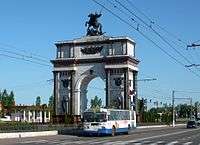 ZiU-682G trolleybus
ZiU-682G trolleybus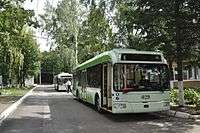 BKM-321 low-floor trolleybus
BKM-321 low-floor trolleybus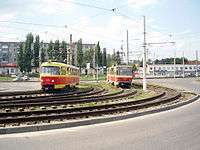 Tatra T3SU and Tatra T6B5SU trams
Tatra T3SU and Tatra T6B5SU trams
Culture and sports
Kursk State University is home to the Russian Chamber Orchestra, under the direction of conductor and trumpet soloist Sergey Proskurin. The orchestra performs regularly, tours internationally and has produced multiple CDs.[18]
Pushkin Theater located in the center of the city. It has permanent company as well as visiting shows.
In 2016, the Russian Women's Hockey League expanded to Kursk, with new club Dynamo Kursk.
Media
Kursk hams since 1935 could receive television broadcasts from Moscow. In 1960, the Committee on Radio and Television was created by the in Kursk Oblast Executive Committee. The first transmission of local television aired January 14, 1961.[19] Main fixed line and cellular operators are active in the city.
Climate
| Climate data for Kursk (1981–2010) | |||||||||||||
|---|---|---|---|---|---|---|---|---|---|---|---|---|---|
| Month | Jan | Feb | Mar | Apr | May | Jun | Jul | Aug | Sep | Oct | Nov | Dec | Year |
| Record high °C (°F) | 7.5 (45.5) |
9.5 (49.1) |
18.9 (66.0) |
28.1 (82.6) |
32.6 (90.7) |
36.5 (97.7) |
37.2 (99.0) |
38.8 (101.8) |
30.9 (87.6) |
26.8 (80.2) |
17.7 (63.9) |
10.2 (50.4) |
38.8 (101.8) |
| Average high °C (°F) | −3.6 (25.5) |
−3.2 (26.2) |
2.5 (36.5) |
12.3 (54.1) |
19.6 (67.3) |
22.9 (73.2) |
24.8 (76.6) |
23.9 (75.0) |
17.5 (63.5) |
10.2 (50.4) |
1.8 (35.2) |
−2.6 (27.3) |
10.5 (50.9) |
| Daily mean °C (°F) | −6.2 (20.8) |
−6.2 (20.8) |
−0.9 (30.4) |
7.6 (45.7) |
14.3 (57.7) |
17.7 (63.9) |
19.6 (67.3) |
18.5 (65.3) |
12.7 (54.9) |
6.5 (43.7) |
−0.6 (30.9) |
−5.1 (22.8) |
6.5 (43.7) |
| Average low °C (°F) | −8.7 (16.3) |
−9.0 (15.8) |
−4.0 (24.8) |
3.4 (38.1) |
9.3 (48.7) |
13.0 (55.4) |
14.9 (58.8) |
13.7 (56.7) |
8.7 (47.7) |
3.4 (38.1) |
−2.8 (27.0) |
−7.6 (18.3) |
2.9 (37.2) |
| Record low °C (°F) | −34.5 (−30.1) |
−35.3 (−31.5) |
−32.6 (−26.7) |
−15.6 (3.9) |
−6.1 (21.0) |
0.4 (32.7) |
5.9 (42.6) |
1.9 (35.4) |
−3.9 (25.0) |
−17.4 (0.7) |
−25.0 (−13.0) |
−32.7 (−26.9) |
−35.3 (−31.5) |
| Average precipitation mm (inches) | 47 (1.9) |
42 (1.7) |
40 (1.6) |
46 (1.8) |
53 (2.1) |
71 (2.8) |
78 (3.1) |
54 (2.1) |
67 (2.6) |
58 (2.3) |
46 (1.8) |
46 (1.8) |
648 (25.5) |
| Average rainy days | 9 | 8 | 9 | 15 | 16 | 17 | 17 | 13 | 16 | 16 | 14 | 11 | 161 |
| Average snowy days | 23 | 21 | 15 | 4 | 0.4 | 0 | 0 | 0 | 0.4 | 3 | 13 | 22 | 102 |
| Average relative humidity (%) | 86 | 83 | 78 | 66 | 61 | 68 | 69 | 67 | 74 | 80 | 87 | 87 | 76 |
| Mean monthly sunshine hours | 62 | 79 | 120 | 175 | 258 | 278 | 282 | 255 | 180 | 118 | 45 | 36 | 1,888 |
| Source 1: Pogoda.ru.net[20] | |||||||||||||
| Source 2: NOAA (sun, 1961–1990)[21] | |||||||||||||
Honors
- A minor planet 3073 Kursk discovered by Soviet astronomer Nikolai Chernykh in 1979 is named after the city.[22]
- The Russian submarine Kursk was named after the city.
Notable people
- Georgy Sviridov, composer
- Valery Chaplygin, Olympic champion, cyclist
- Alexander Deyneka, painter, sculptor
- Alexander Rutskoy, politician
- Seraphim of Sarov, monk and saint
- The Tolmachevy Twins, singers
- Alexander Povetkin, Olympic champion, boxer
- Alexey Ivanovich Borozdin, musical therapist
- Yevgeny Klevtsov, Olympic medalist, cyclist
- Vyacheslav Klykov, sculptor
- Kazimir Malevich, painter
- Sergei Puskepalis, actor
- Mikhail Shchepkin, actor.
- Little Tragedies, music band
Twin towns – sister cities
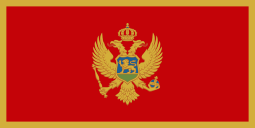














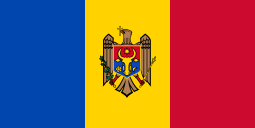


References
Notes
- Resolution #489
- "Kursk". sochi2014.com. Retrieved April 4, 2014.
- The Encyclopædia Britannica: A Dictionary of Arts, Sciences, and General Literature, Volume 14. Maxwell Sommerville. 1894. p. 162.
- БД ПМО Курской области. Город Курск
- Russian Federal State Statistics Service (2011). "Всероссийская перепись населения 2010 года. Том 1" [2010 All-Russian Population Census, vol. 1]. Всероссийская перепись населения 2010 года [2010 All-Russia Population Census] (in Russian). Federal State Statistics Service.
- "26. Численность постоянного населения Российской Федерации по муниципальным образованиям на 1 января 2018 года". Federal State Statistics Service. Retrieved January 23, 2019.
- Russian Investment, Economic, Ecological and Business Risk Atlas. Int'l Business Publications. 2005. p. 177. ISBN 9780739706558.
- Russia Regional Government Encyclopedic Directory. Int'l Business Publications. 2009. p. 207. ISBN 9781438740836.
- Law #48-ZKO
- "Об исчислении времени". Официальный интернет-портал правовой информации (in Russian). June 3, 2011. Retrieved January 19, 2019.
- Local post office info – http://www.russianpost.ru/PostOfficeFindInterface/FindOPSByPostOfficeID.aspx?index=305000
- Russian Federal State Statistics Service (May 21, 2004). "Численность населения России, субъектов Российской Федерации в составе федеральных округов, районов, городских поселений, сельских населённых пунктов – районных центров и сельских населённых пунктов с населением 3 тысячи и более человек" [Population of Russia, Its Federal Districts, Federal Subjects, Districts, Urban Localities, Rural Localities—Administrative Centers, and Rural Localities with Population of Over 3,000] (XLS). Всероссийская перепись населения 2002 года [All-Russia Population Census of 2002] (in Russian).
- "Всесоюзная перепись населения 1989 г. Численность наличного населения союзных и автономных республик, автономных областей и округов, краёв, областей, районов, городских поселений и сёл-райцентров" [All Union Population Census of 1989: Present Population of Union and Autonomous Republics, Autonomous Oblasts and Okrugs, Krais, Oblasts, Districts, Urban Settlements, and Villages Serving as District Administrative Centers]. Всесоюзная перепись населения 1989 года [All-Union Population Census of 1989] (in Russian). Институт демографии Национального исследовательского университета: Высшая школа экономики [Institute of Demography at the National Research University: Higher School of Economics]. 1989 – via Demoscope Weekly.
- The Song of Igor's Campaign, Igor son of Svyatoslav and grandson of Oleg. Translated by Vladimir Nabokov. 78–95
- "Dr. Ed Norris, World Indigenous Missions, 2007". Archived from the original on September 30, 2007. Retrieved July 29, 2007.
- "Railway Station in Kursk {{in lang|ru}}". Archived from the original on March 23, 2012. Retrieved December 1, 2012.
- На общественном транспорте в Курске запущена система контроля оплаты проезда (in Russian). Официальный сайт Главы города Курска и Курского городского Собрания. September 14, 2011. Archived from the original on October 27, 2012. Retrieved October 8, 2011.
- "Russian Chamber Orchestra". Archived from the original on January 31, 2008.
- "ГТРК "Курск": 50 лет в эфире". ИА KURSKCiTY. September 21, 2010. Retrieved March 28, 2011.
- "Weather and Climate - The Climate of Kursk" (in Russian). Weather and Climate (Погода и климат). Retrieved April 6, 2016.
- "Kursk Climate Normals 1961–1990". National Oceanic and Atmospheric Administration. Retrieved April 6, 2016.
- Dictionary of Minor Planet Names, p.253
- "Партнерские связи". kurskadmin.ru (in Russian). Kursk. Archived from the original on July 3, 2016. Retrieved February 4, 2020.
Sources
- Губернатор Курской области. Постановление №489 от 6 ноября 2008 г. «Об утверждении реестра административно-территориальных единиц населённых пунктов Курской области», в ред. Постановления №26-пг от 29 января 2013 г. «О внесении изменений и дополнений в Постановление Губернатора Курской области от 06.11.2008 №489 "Об утверждении реестра административно-территориальных единиц населённых пунктов Курской области"». Вступил в силу 6 ноября 2008 г. (Governor of Kursk Oblast. Resolution #489 of November 6, 2008 On the Adoption of the Registry of the Administrative-Territorial Units and Inhabited Localities of Kursk Oblast, as amended by the Resolution #26-pg of January 29, 2013 On Amending and Supplementing Resolution #489 of the Governor of Kursk Oblast of November 6, 2008 "On the Adoption of the Registry of the Administrative-Territorial Units and Inhabited Localities of Kursk Oblast". Effective as of November 6, 2008.).
- Курская областная Дума. Закон №48-ЗКО от 21 октября 2004 г. «О муниципальных образованиях Курской области», в ред. Закона №65-ЗКО от 23 августа 2011 г. «О внесении изменений и дополнений в Закон Курской области "О границах муниципальных образований Курской области", Закон Курской области "О муниципальных образованиях Курской области"». Вступил в силу со дня официального опубликования. Опубликован: "Курская правда", №214, 30 октября 2004 г. (Kursk Oblast Duma. Law #48-ZKO of October 21, 2004 On the Municipal Formations of Kursk Oblast, as amended by the Law #65-ZKO of August 23, 2011 On Amending and Supplementing the Law of Kursk Oblast "On the Borders of the Municipal Formations of Kursk Oblast", Law of Kursk Oblast "On the Municipal Formations of Kursk Oblast". Effective as of the day of the official publication.).
External links
| Wikimedia Commons has media related to Kursk. |
